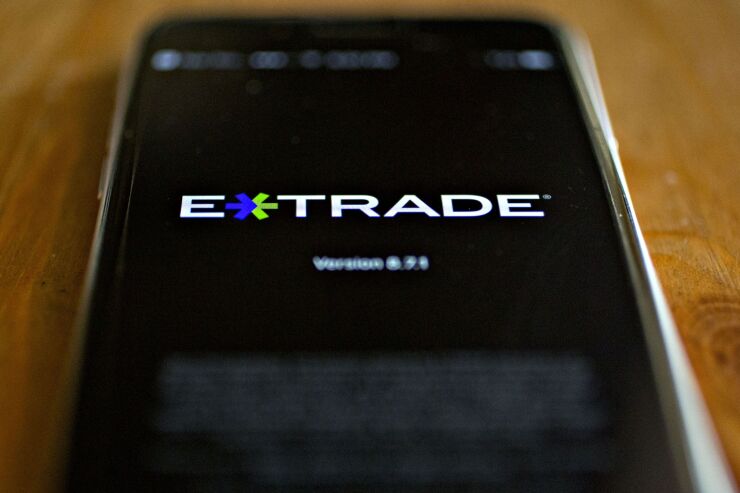Morgan Stanley’s $13 billion deal for E-Trade illustrates a larger trend in digital wealth management: mega deals that are primarily about building in diversification.
Firms are constructing all-in-one platforms meant to house every client need — firms like the microsavings app
By offering a buffet of financial services, like managed investment accounts, lending products, checking accounts and retirement vehicles to an array of client segments, financial services giants have broken down the barriers between wealth management and traditional financial services.
If this trend continues, in the near future, the ultimate financial services giant could be akin to a Walmart, where mass affluent customers can purchase a slew of finance products at an affordable price point.
That transformation is at the heart of Morgan Stanley’s mega deal for E-Trade.
“Morgan Stanley continues its march into the world of the mass affluent,” says Will Trout, head of wealth managment at the consulting firm Celent. The deal is “fully consistent with the idea of the ‘one-stop shop’ trumpeted by everyone from Wealthfront to Ally Bank to the other wirehouses.”

The combined platform will have $3.1 trillion in client assets and 8.2 million retail client relationships, according to a release. The deal also fills gaps in service through complementary offerings and enhanced digital capabilities.
The all-in-one platform model is an increasingly attractive strategy for some of the largest global firms — including some of the world’s tech giants. Apple, for example, launched its credit card in March. In November, Google said it would look to partner with Citigroup to offer checking accounts sometime in 2020. While the firms may use the accounts to collect client data and peek more deeply into customers’ behavior, they are also seen as making big incursions into the traditional purview of wealth management.
“It makes sense to try and serve the full spectrum of financial needs,” says Jennifer Butler, director of asset management at the New York-based consultancy firm Corporate Insight.
“Smaller competitors and startups — like Betterment and Wealthfront — have foreseen this and have made moves to keep assets in-house, such as expanding into banking, lending, recordkeeping and workplace solutions.”
Statistics back this up, with 61% of investors agreeing or strongly agreeing that they would like to have the majority of their financial accounts with their main brokerage firm, according to an upcoming Corporate Insight survey of 1,550 investors fielded in August.
Assets managed on digital investment platforms are expected to top $1.26 trillion in 2023, up from just $283 billion currently, according to a study by the Boston-based consultancy Aite Group.
E-Trade’s digital platform, Core Portfolios, manages more than $5.6 billion in client assets with a starting price of 30 basis points, according to the Aite report. Morgan Stanley rolled out its robo advisor, Access Investing, in 2017 with a $5,000 minimum and a 35 basis point fee, although the report did not track its AUM. (Wall Street incumbents often do not break down assets on digital platforms, according to the report.)
New startups are already looking to branch into even more tangential alternative investment vehicles, according to a recent CB Insights’ The State of Fintech report. The digital platform, Alto, for example, offers a platform for clients to invest in private equity, venture capital, real estate and cryptocurrency. The startup landed $3.5 million in Series A funding in the first quarter of 2020.
The Morgan Stanley deal will also help place the firm in the digital RIA segment — a position its competitors have already solidified.
“The combination represents a compelling proposition for RIAs seeking to scale up and leverage the Morgan Stanley brand and product mix,” says Celent’s Trout. “Of course, this proposition won’t appeal to many of the smaller RIAs, but it should resonate with the long tail of fast-growing independent firms.”
After last year’s
Corporate Insight’s Butler points out that, “E-Trade’s slice of the RIA market is still pretty small,” but that with the backing of a Wall Street giant, E-Trade Advisors may become a strong competitor. The deal could also result in the RIA custody business becoming a strategic focus for Morgan Stanley, she says.
Is it fair to wonder, then, if Morgan Stanley is following its competitors into the RIA space?
“I wouldn’t be surprised to see Morgan Stanley look to buy someone, as Goldman Sachs did with United Capital,” Trout says.
In all events, firms large and small will need to pay attention to the overall financial wellness of a client, say Eric Sandrib, a wealth management analyst at the Boston-based consultancy Aite Group.
“We can expect Morgan Stanley’s presence in the digital wealth space to grow over time,” says Sandrib. “In doing so, more products and services will inevitably need to be offered.”







